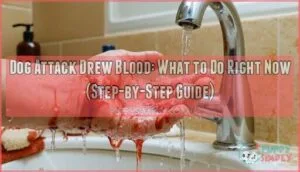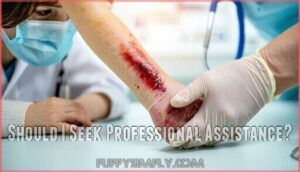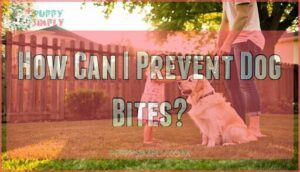This site is supported by our readers. We may earn a commission, at no cost to you, if you purchase through links.
 When a dog attack drew blood, you’re facing a Level 3 bite that needs immediate attention.
When a dog attack drew blood, you’re facing a Level 3 bite that needs immediate attention.
First, wash the wound thoroughly with soap and warm water for at least five minutes. Apply pressure with a clean cloth to stop bleeding, then cover with sterile bandages.
Don’t panic – this happens more often than you’d think, even with the sweetest pups. Secure your dog in a separate room to prevent further incidents.
Take photos of injuries for documentation. If puncture wounds are deep or gaping, seek medical care within six hours.
Understanding what triggered this behavior is your next key step, to prevent future incidents and ensure your dog’s behavior is addressed in a timely manner, which can be a critical requirement for maintaining a safe environment, and also consider it as a key step.
Table Of Contents
- Key Takeaways
- What is a Dog Attack?
- Signs of a Serious Dog Attack
- What to Do Immediately After a Dog Attack
- How Can I Tell if a Dog Bite is Serious?
- Should I Seek Professional Assistance?
- Is My Dog Dangerous if He Bites?
- How Can I Prevent Dog Bites?
- What Should I Do if I’ve Been Bitten?
- Frequently Asked Questions (FAQs)
- What happens if a dog bites you and drew blood?
- What should I do if my dog attacked my other dog and drew blood?
- Do I need a tetanus shot if a dog bites me?
- Do I need to go to the doctor if my dog bites me?
- How can I tell if a dog bite is serious?
- What should I do if I’ve been bitten?
- Should I seek professional assistance after a dog attack?
- What are the signs of a serious dog attack?
- Is my dog dangerous if he bites?
- Will my homeowners insurance cover dog bite damages?
- Conclusion
Key Takeaways
- Act immediately when blood’s drawn – You’ll need to wash the wound with soap and warm water for 5 minutes, apply pressure to stop the bleeding, and seek medical attention within 8 hours to prevent infection and complications.
- Secure your dog right away – You must contain your dog in a separate room or crate immediately after the incident to prevent further attacks and protect everyone involved while emotions settle.
- Don’t assume your dog’s dangerous – One bite doesn’t make your dog inherently dangerous, but you’ll need to identify triggers like fear or resource guarding and work with professional trainers to address underlying behavioral issues.
- Document everything for your protection – You should take photos of the injuries, gather witness information, and report the incident to authorities for legal protection and community safety while monitoring for signs of infection like swelling or unusual discharge.
What is a Dog Attack?
A dog attack involves aggressive behavior where a dog intentionally bites, snaps, or lunges at a person or another animal, often drawing blood.
Unlike playful nipping, a true attack shows clear intent to harm through sustained aggression or multiple bites.
The attack definition encompasses everything from single defensive bites to serious dog mauling incidents.
Bite severity varies greatly—from minor punctures to deep lacerations requiring medical attention.
Attack context matters too, as fear, territoriality, or resource guarding often trigger these incidents, regardless of breed influence on the dog’s natural temperament.
Signs of a Serious Dog Attack
When your dog attack drew blood, recognizing severity markers becomes essential for proper response.
Look for deep puncture wound depth that penetrates beyond surface skin layers.
Assess bleeding severity—continuous flow versus light spotting signals different urgency levels.
Watch for infection indicators like increasing redness, warmth, or unusual discharge around bite areas.
Monitor for mobility impairment if limbs were affected.
Notice behavioral changes in your pet—excessive hiding, aggression, or lethargy often indicate serious dog bite injury requiring immediate dog bite medical treatment and professional dog bite first aid intervention.
What to Do Immediately After a Dog Attack
When a dog attack draws blood, your immediate actions can make the difference between a manageable situation and serious complications.
When blood flows from a dog bite, your next few minutes determine whether you’re facing a minor incident or a medical emergency.
You’ll need to control bleeding, secure the area, and assess the severity of injuries while keeping yourself and others safe from further harm.
Provide First Aid
Once you’ve identified a serious dog attack drew blood, your first priority is stopping the bleeding. Apply firm pressure with a clean cloth to control bleeding immediately.
Wash the wound with mild soap and warm water for 10-15 minutes to assess wounds thoroughly. Look for infection signs like excessive redness or swelling.
Using appropriate antiseptic products is essential for preventing infection. Apply antiseptic to broken skin, then bandage securely.
Pain management can include over-the-counter medications if needed. Change the bandage daily and monitor for 14 days to ensure proper wound cleaning and prevent serious complications later, which is crucial for preventing infection and promoting healing.
Secure Your Dog
After addressing the immediate medical needs, your next priority is containing your dog to prevent further incidents. Think of this as damage control – you need to create a safe barrier between your dog and potential triggers.
Secure your dog in a crate, separate room, or with a sturdy leash. This isn’t punishment; it’s protection for everyone involved. If your dog shows signs of dog aggression, a properly fitted muzzle can provide additional safety during this stressful time.
Muzzle training before emergencies makes this process smoother and less traumatic. A suitable option is to find a durable wire crate for secure containment. Check your containment systems – are your fences secure? Many dog bite prevention issues stem from inadequate barriers.
Leash laws exist for good reason, and dog owner responsibility extends beyond your property lines. Avoid supervised play or interactions until you’ve assessed the situation fully. Your dog’s stress levels are likely elevated, making them unpredictable.
Professional dog training may be necessary moving forward to address underlying behavioral issues.
Reapproaching Your Dog
After securing your dog, rebuilding trust requires patience and careful planning. The emotional impact of a dog bite creates anxiety for both you and your pet, making gradual reintroduction essential for everyone’s safety.
Start your approach with these key steps:
- Use a happy voice when calling your dog’s name to signal you’re not angry or afraid
- Take a break from each other to let emotions settle before attempting contact
- Keep a long leash attached if your dog tends to flee when stressed
- Introduce supervised interactions slowly, watching for signs of dog aggression or anxiety
Muzzle training becomes vital during this phase, as it allows safe interactions while you work on trust rebuilding. Utilizing proper muzzle selection can greatly improve safety during training. Positive reinforcement helps reshape your dog’s behavior and reduces future bite risks.
Remember, understanding dog behavior patterns helps prevent similar incidents. Your calm demeanor signals safety to your anxious pet during this delicate reintroduction process.
How Can I Tell if a Dog Bite is Serious?
Bite-wound assessment determines whether you’re dealing with a minor scratch or medical emergency.
Any dog bite that breaks skin requires attention, but severity varies substantially.
Watch for these critical warning signs:
- Deep puncture wounds or torn skin indicating significant tissue damage
- Heavy bleeding that won’t stop with direct pressure after 10 minutes
- Infection symptoms like increasing swelling, redness, warmth, or pus drainage
- Nerve damage signs including numbness, tingling, or difficulty moving affected areas
Rabies risk increases with unknown vaccination status, making immediate medical treatment essential for proper wound care.
Should I Seek Professional Assistance?
When a dog attack draws blood, professional help isn’t optional—it’s necessary.
Beyond immediate wound care and infection risk assessment, you’ll need thorough support. Medical attention addresses physical injuries, while trainer assessment evaluates your dog’s behavior patterns.
| Professional Type | When to Contact | What They Provide |
|---|---|---|
| Medical Doctor | Within 8 hours of bite | Wound evaluation, antibiotics, tetanus shots |
| Veterinary Behaviorist | After any biting incident | Behavior modification plans, medication options |
| Professional Trainer | Before reintroducing dog | Safety protocols, owner confidence building, long-term prognosis |
This multi-professional approach guarantees both immediate safety and future prevention.
Is My Dog Dangerous if He Bites?
Does one bite make your dog dangerous? Not necessarily. Any dog can bite when provoked, but bite severity matters more than breed stereotypes.
A single nip differs vastly from repeated attacks. Consider dog bite causes like fear, pain, or resource guarding when evaluating dog behavior.
Previous bites increase owner liability and suggest underlying dog aggression issues. Rehabilitation options exist through professional trainers, but some cases require rehoming considerations.
Watch for dog bite warning signs like growling or stiff posture to prevent future incidents.
How Can I Prevent Dog Bites?
Prevention starts with understanding your dog’s warning signs and creating a safe environment.
Early socialization helps puppies adapt to new situations, while training consistency builds trust and obedience.
Here’s how to reduce bite risks:
- Supervise interactions between children and dogs closely
- Identify triggers like food guarding or territorial behavior
- Practice muzzle training for stressful situations or vet visits
- Watch for dog bite warning signs like stiff posture or growling
Regular exercise prevents frustration-based dog aggression, and teaching basic commands strengthens your bond while promoting dog safety.
What Should I Do if I’ve Been Bitten?
Getting attacked changes everything in an instant. Your first priority is controlling bleeding with direct pressure using a clean cloth. Next, wash the wound thoroughly with soap and lukewarm water for five minutes to reduce infection risk. Don’t panic – proper wound care makes all the difference.
When a dog attack draws blood, your immediate response can mean the difference between recovery and serious complications.
| Immediate Action | Why It Matters |
|---|---|
| Apply direct pressure | Stops bleeding quickly |
| Clean with soap/water | Reduces infection risk |
| Monitor for swelling/redness | Catches infection symptoms early |
| Seek medical attention within 8 hours | Prevents serious complications |
Report the incident to authorities for legal protection and community safety. Document everything – photos, witness contacts, and medical records help with potential legal ramifications. Don’t underestimate emotional trauma either; dog bite treatment includes addressing psychological impacts.
Watch for infection symptoms like increased pain, fever, or discharge. Professional wound cleaning and antibiotics often prevent serious complications.
Frequently Asked Questions (FAQs)
What happens if a dog bites you and drew blood?
Ever wonder how serious a bleeding dog bite really is?
You’ll need immediate medical attention within eight hours.
Clean the wound thoroughly, apply pressure to stop bleeding, and watch for infection signs like swelling or redness.
What should I do if my dog attacked my other dog and drew blood?
Separate the dogs immediately and secure them in different rooms. Clean the injured dog’s wounds with lukewarm water and soap. Apply pressure to control bleeding, then seek veterinary care promptly.
Do I need a tetanus shot if a dog bites me?
Tetanus bacteria thrives in 80% of puncture wounds.
You’ll need a tetanus shot if your last one was over five years ago or you can’t remember when you got it.
Don’t gamble with lockjaw.
Do I need to go to the doctor if my dog bites me?
Yes, you should see a doctor within 8 hours of any dog bite that breaks skin. Even minor wounds need professional evaluation for infection risk, proper cleaning, and potential antibiotic treatment.
How can I tell if a dog bite is serious?
Like a crime scene investigator examining evidence, you’ll know a dog bite needs urgent care if it’s deep enough to see fat or muscle.
It won’t stop bleeding, or shows infection signs like redness and swelling, which are critical indicators that require urgent attention.
What should I do if I’ve been bitten?
Clean the wound immediately with soap and warm water for five minutes. Apply pressure to control bleeding, then cover with a sterile bandage. Seek medical attention within eight hours.
Should I seek professional assistance after a dog attack?
Professional help’s essential if you’re dealing with fear-based aggression, multiple bites, or children in your home. Don’t wait—contact a veterinary behaviorist or certified trainer immediately to prevent future incidents.
What are the signs of a serious dog attack?
Deep puncture wounds, excessive bleeding, torn flesh, and multiple bite marks signal serious attacks.
You’ll notice the victim showing shock, difficulty breathing, or loss of consciousness.
Immediate emergency care becomes critical when blood won’t stop flowing.
Is my dog dangerous if he bites?
One bite doesn’t automatically make your dog dangerous, but it’s a serious warning sign.
You’ll need to identify triggers, assess the severity, and work with professionals to prevent future incidents through training.
Will my homeowners insurance cover dog bite damages?
Your coverage might vanish when you need it most.
Most homeowners policies cover dog bites, but exclusions exist for certain breeds or prior incidents.
Check your policy immediately—some insurers drop coverage after claims.
Conclusion
Remember, when your dog attack drew blood, swift action becomes your lifeline.
You’ve learned the essential steps: immediate wound care, securing your pet, and knowing when medical attention’s necessary.
Don’t let fear cloud your judgment about your dog’s future behavior, as most bites stem from specific triggers that can be managed with proper training and environmental changes.
Stay vigilant, but remember that one incident doesn’t define your dog’s character, and with quick response and prevention measures, everyone will be safe moving forward.














